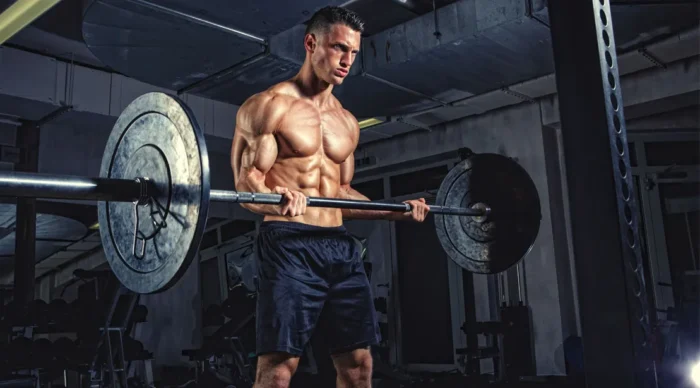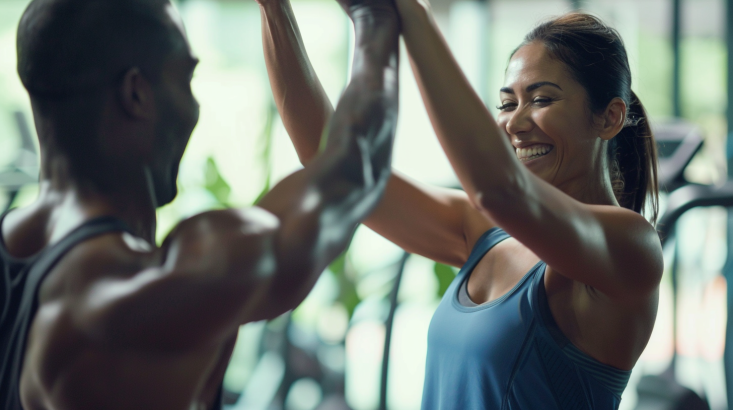Are you feeling stuck in your fitness journey, trying hard to see muscle gains or strength improvements but not getting anywhere? You’re not alone. Many face this hurdle, unsure of how to leap over it for better results. One powerful tool lies in the world of barbell workout — a method proven to kick start muscle and strength development unlike any other.
Research shows that integrating barbell exercises into your routine boosts not just physical power but also enhances overall functional fitness, making everyday activities easier. Our guide will walk you through the ins and outs of barbell training, from squats that strengthen your lower body to bench presses that build upper body might.
With essential tips on form and injury prevention plus a peek at different types of barbells like Olympic and EZ curl ones, we’ve got all bases covered. Excited yet? Let’s get lifted!
Benefits of incorporating barbell workouts
Incorporating barbell workouts benefits your body by building strength and muscle growth. It also enhances functional fitness, offering a variety of exercises to target different muscle groups.
Strength and muscle growth
Barbell workouts are key for boosting strength and musculature. Lifting heavy weights, like those offered by Olympic barbells, triggers your body to build more muscle fibre. This process, known as hypertrophy, is essential for getting stronger and bigger.
Engaging in exercises such as squats and deadlifts not only works out major muscle groups but also promotes the release of hormones that aid in muscle growth.
Using different types of barbells adds variety to your training, ensuring all muscle groups get attention. Whether it’s a safety squat bar for lower back support during squats or an EZ curl barbell for focused arm workouts, each type has its place in a comprehensive strength training regime.
Consistently challenging your muscles with weight plates increases their size and power over time, enabling significant improvements in overall physicality and functional fitness.
Improved functional fitness
Improved functional fitness means better performance in daily tasks. Lifting barbells builds strength that applies to real-world activities. This could be anything from carrying shopping bags to moving furniture.
It’s about making life easier and reducing the risk of injury during everyday activities.
Training with weights like Olympic barbells and kettlebells improves how well your muscles work together. This helps with stability, mobility, and the ability to do complex movements.
Think of functional fitness as preparing your body for any physical challenge it might face, from sprinting for a bus to taking part in a CrossFit session.
Next up, let’s look at the variety of exercises you can perform with different types of barbells.
Versatility in exercises
Building on the benefits of better functional fitness, barbell workouts offer a variety of exercises. You can use different types of barbells like Olympic barbells, EZ curl bars and trap bars for a range of movements.
These tools make it easy to switch between squats, deadlifts, and bench presses. This keeps your routine fresh and challenges different muscles.
With the right equipment like safety squat bars and bumper plates, you can safely perform olympic lifts such as snatches and clean and jerks. Adding these complex moves to your regimen improves agility, power, and strength in real-life actions.
Whether you are into HIIT or powerlifting, integrating diverse barbell exercises helps you achieve comprehensive fitness goals while keeping workouts engaging.
Types of barbells and their uses
When it comes to barbell workouts, different types of barbells offer unique benefits and versatility. Olympic barbells are designed for high-intensity training, whilst EZ curl barbells target specific muscle groups with their curved design.
Trap barbells provide a comfortable grip and are well-suited for deadlifting and other compound exercises.
Olympic barbells
Olympic barbells stand out in weightlifting and high-intensity training. These bars are longer and heavier than standard ones, making them ideal for Olympic weightlifting. They usually weigh around 20 kilograms and have a length that accommodates wide grips.
Their sleeves rotate, thanks to bushings or bearings, allowing users to lift heavy weights without straining their wrists.
Athletes prefer these bars for exercises like deadlifting and squats. The rotation of the sleeves makes it easier to perform compound exercises smoothly. This feature is essential during fast lifts in competitions or training sessions focused on building strength and muscle growth.
Whether you’re gearing up for a competition or just aiming to improve your fitness level, an American barbell provides the stability needed for challenging workouts.
EZ curl barbells
EZ curl barbells stand out for their unique design. They bend in a way that lets you grip them more naturally. This makes exercises like bicep curls and triceps extensions easier on your wrists and forearms.
Many people find they can lift heavier weights with an EZ curl barbell because of this better grip.
Using an EZ curl barbell also reduces the risk of strain or injury during your workout. It’s a great tool whether you’re aiming to build muscle or just get stronger. Plus, wearing a weightlifting belt while using one can offer extra support for your lower back, making it safer to tackle those challenging lifts.
Trap barbells
Trap barbells, also known as hex bars, are a unique type of weightlifting equipment. Their design lets you stand inside the bar while lifting, which changes how your body handles the weight.
This setup can reduce stress on your lower back and make lifts like deadlifts safer for people with back issues. It’s an excellent tool for beginners to start heavy lifting without risking injury.
Using trap barbells also helps in improving grip strength because of their parallel handle position. You can perform a variety of exercises including squats, shrugs, and farmer walks besides just deadlifts.
They prove especially beneficial for athletes looking to enhance their explosive power and functional fitness. Remember to use weightlifting belts when attempting heavier weighs for added support and safety during your workout sessions.
Essential barbell exercises for a full-body workout
To achieve a full-body workout, incorporate barbell exercises such as squats, deadlifts, bench press, shoulder press, and bent-over rows. For further details on how to effectively include these exercises in your routine for maximum results and benefits read more.
Squats
Squats are a key move in any barbell routine, targeting your lower body like no other exercise. By using an Olympic barbell or even a trap bar, you engage muscles across your legs and core.
This makes squats not just about strength but also improving balance and coordination.
To do a squat correctly, stand with your feet shoulder-width apart. Place the barbell across your shoulders, not on your neck. Keep your back straight as you bend at the knees. Lower yourself as if sitting down until your thighs are parallel to the floor.
Push through your heels to stand back up. Repeat this movement for several reps to really work those leg and gluteal muscles.
Deadlifts

Deadlifts are a fundamental compound exercise that engages multiple muscle groups, making it an excellent addition to any barbell workout routine. This exercise primarily targets the lower back, glutes, hamstrings, and core muscles.
To perform a deadlift, stand with your feet hip-width apart, bend at your hips and knees to grip the barbell just outside your legs, then lift it by extending your hips and knees. Deadlifts can aid in building overall strength and improving posture while promoting functional fitness.
By incorporating deadlifts into your workout regimen, you can strengthen various muscle groups simultaneously. Additionally, this exercise helps enhance stability and power as well as contributes to boosting overall athletic performance.
As part of a full-body workout routine using barbells such as Olympic or trap barbells for added versatility and intensity.
Bench press
The bench press is a classic barbell exercise that primarily targets the chest, shoulders, and triceps. To perform a bench press, lie on a flat bench with your feet planted firmly on the ground.
Grip the bar slightly wider than shoulder-width apart and lower it to your chest before pushing it back up to full arm extension. It’s essential to maintain proper form throughout the movement by keeping your back arched and your elbows tucked in.
This compound exercise not only builds upper body strength but also engages core stability during execution.
When performing the bench press, ensure that you engage your chest muscles as you push up and control the weight as you bring it down to avoid injury or strain. As an integral part of any strength training routine, mastering this exercise can lead to increased overall upper body strength and muscle development over time.
Shoulder press
The shoulder press is a foundational barbell exercise that primarily targets the deltoid muscles of the shoulders. To perform this exercise, stand with your feet shoulder-width apart and grip the barbell slightly wider than shoulder-width.
Lift the barbell from a rack to your chest level, then push it overhead until your arms are fully extended. Lower the bar back to your chest and repeat for the desired number of repetitions.
This compound movement not only strengthens the shoulders but also engages several stabilising muscles in the core and upper body.
By incorporating variations like seated or standing shoulder presses, you can adjust focus on different parts of the deltoids. It’s important to execute proper form by keeping a neutral spine, engaging your core, and avoiding arching your back during this movement.
Gradually increase weight as you build strength to ensure continued progress while preventing injuries.
Bent-over rows
Now onto bent-over rows. This exercise targets the muscles in your upper and middle back, as well as your biceps. To do this exercise, stand with your feet shoulder-width apart, knees slightly bent, and hold a barbell with an overhand grip, hands slightly wider than shoulder-width.
Keep your back straight and bend at the hips until your torso is parallel to the floor. Pull the barbell up towards your lower chest while keeping your elbows close to your body. Lower the barbell back down to complete one repetition.
This exercise can help strengthen the muscles in your upper back while also engaging your biceps for added arm strength. Make sure to maintain proper form throughout to avoid strain or injury.
Creating a barbell workout routine
Crafting a barbell workout routine involves careful consideration and planning. It’s about selecting the right exercises, establishing goals, and progressing effectively in your training journey.
This framework is crucial for achieving optimal results and avoiding plateaus. For more detailed guidance on creating an effective barbell workout routine tailored to your fitness goals, keep reading!
Warm-up and cool down
Before starting your barbell workout, engage in a dynamic warm-up to get your blood flowing and prepare your muscles for the upcoming exercise. This can include light cardio, such as jogging or skipping, and dynamic stretches like leg swings and arm circles.
Following your workout session, cool down with static stretching to help relax the muscles and prevent stiffness. Incorporating both warm-up and cool down routines into your barbell workouts helps lower the risk of injury and enhance flexibility.
Remember that proper warm-ups not only prime your body for exercise but also improve performance during the workout by increasing blood flow to the working muscles. Similarly, cooling down is essential in allowing your heart rate to slowly return to normal levels whilst aiding in preventing muscle soreness post-exercise.
Always make time for these valuable routines before and after using barbells.
Setting goals
Setting goals is a crucial step in creating an effective barbell workout routine. Whether aiming to increase strength, improve muscle definition, or enhance overall fitness levels, establishing clear and achievable objectives provides direction and motivation.
When setting goals for a barbell workout, it’s important to consider personal fitness aspirations and tailor the plan accordingly. By outlining specific targets such as increasing weight lifted, mastering proper form, or achieving a certain number of repetitions, individuals can track progress and celebrate achievements along their fitness journey.
To maximise the effectiveness of a barbell workout routine, it’s essential to set both short-term and long-term goals. Short-term goals provide immediate milestones to work towards while long-term objectives offer a broader perspective on overall progress and improvement.
Additionally, incorporating variety into these goals by targeting different muscle groups or focusing on various aspects of physical fitness contributes to a well-rounded approach that supports holistic development.
Increasing weight and progressing
As you get stronger, gradually add more weight to your barbell exercises. Aim for an increase of around 5-10% from one workout to the next. This progressive approach helps build muscle and strength over time without risking injury.
To track your progress, keep a workout journal or use an app to record the amount of weight lifted in each session. This will help you stay focused on your goals and continue challenging yourself as you advance in your training.
Tips for proper form and injury prevention
Maintain proper alignment when lifting weights to avoid injury. Start with lighter weights and listen to your body for cues during your workout.
Maintaining proper body alignment
To maintain proper body alignment during barbell exercises, focus on keeping your head, shoulders, and hips in a straight line. Engage your core muscles to support your spine and avoid arching or rounding the back.
Ensure that your knees are directly above your ankles in exercises like squats and deadlifts to prevent injury. Pay attention to foot placement for stability and balance, distributing weight evenly between both feet.
When performing shoulder press or bench press, keep your chest up and maintain a natural curve in the lower back while avoiding excessive arching. For bent-over rows, hinge at the hips with a slight bend in the knees while keeping the back flat.
Overall, maintaining proper body alignment not only reduces the risk of injury but also helps you maximise the effectiveness of each exercise.
Starting with lighter weights
Begin with lighter weights to master your form and prevent injury. Gradually increase the weight as you build strength and confidence, ensuring a safe and effective progression in your barbell workout routine.
Listening to your body
Transitioning from starting with lighter weights to listening to your body is crucial for a successful barbell workout routine. It’s important to pay attention to how your body feels during each exercise.
Being attuned to any signs of discomfort or strain can help prevent injuries and ensure that you are progressing safely in your fitness journey.
Adjusting your technique or taking rest when needed, based on the feedback from your body, allows for a more effective and sustainable workout experience. Tuning into your body’s cues ensures that you’re optimising each session without overexertion or unnecessary strain.
Conclusion
Incorporating barbell workout offers numerous benefits such as strength and muscle growth, improved functional fitness, and exercise versatility. The essential barbell exercises outlined can provide an efficient full-body workout routine when performed with proper form.
By focusing on practicality and efficiency, individuals can set achievable goals while emphasising the importance of maintaining proper body alignment to prevent injuries. Furthermore, these strategies have the potential to lead to significant improvements in overall fitness levels.
Are you ready to embark on your barbell workout journey? Take action and achieve your fitness goals today!






One Response
❤️ this.